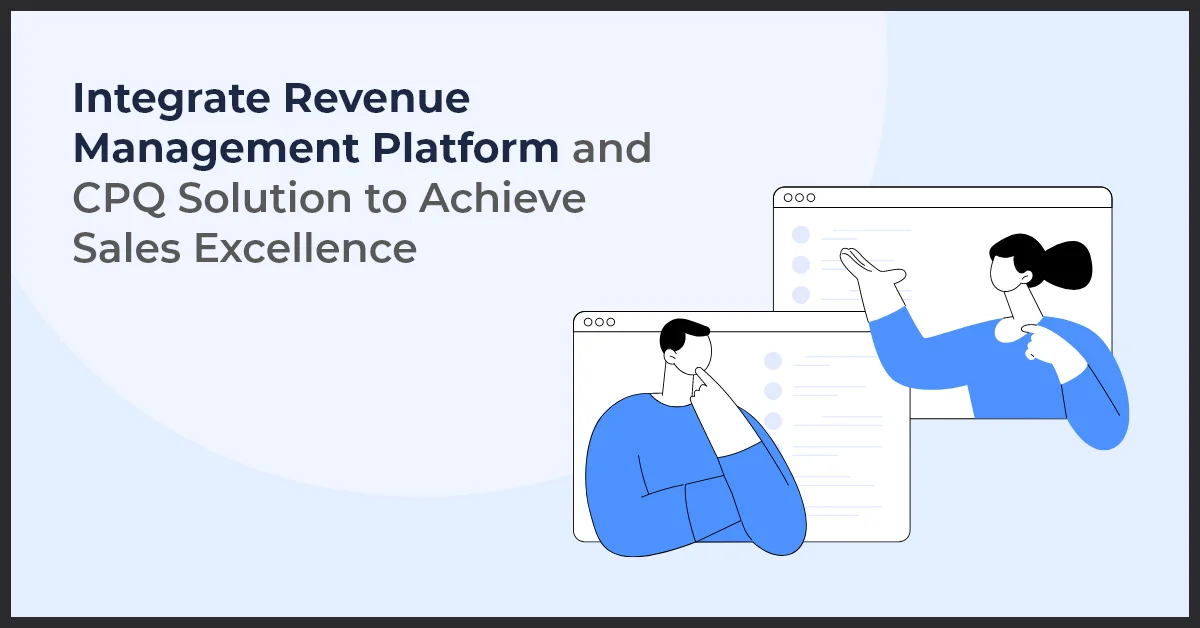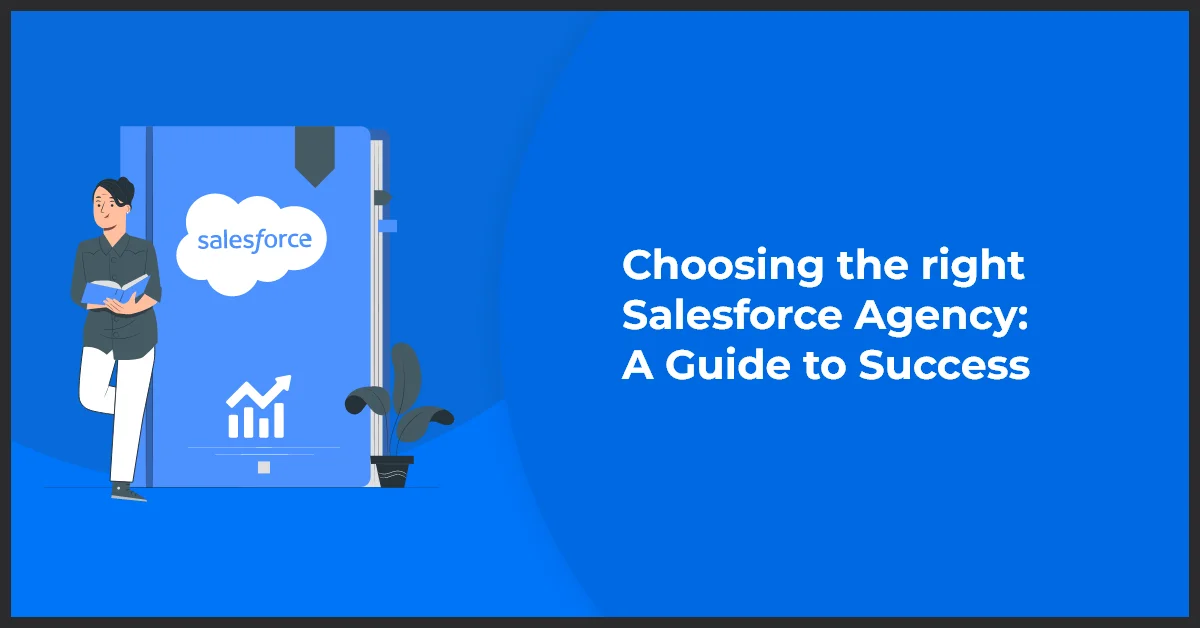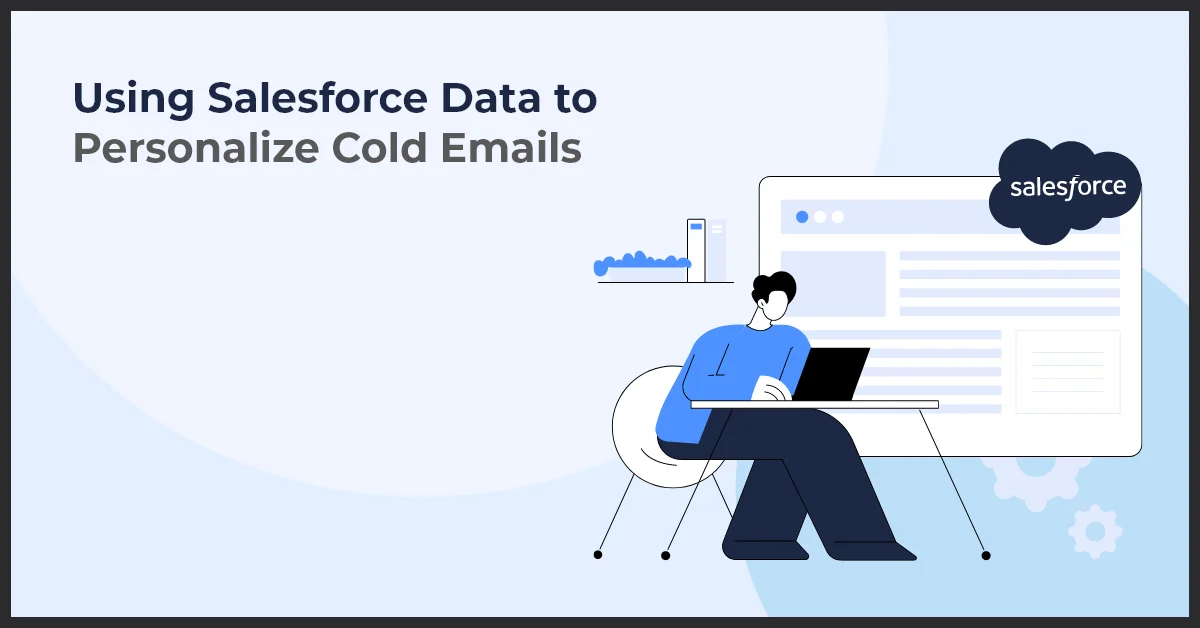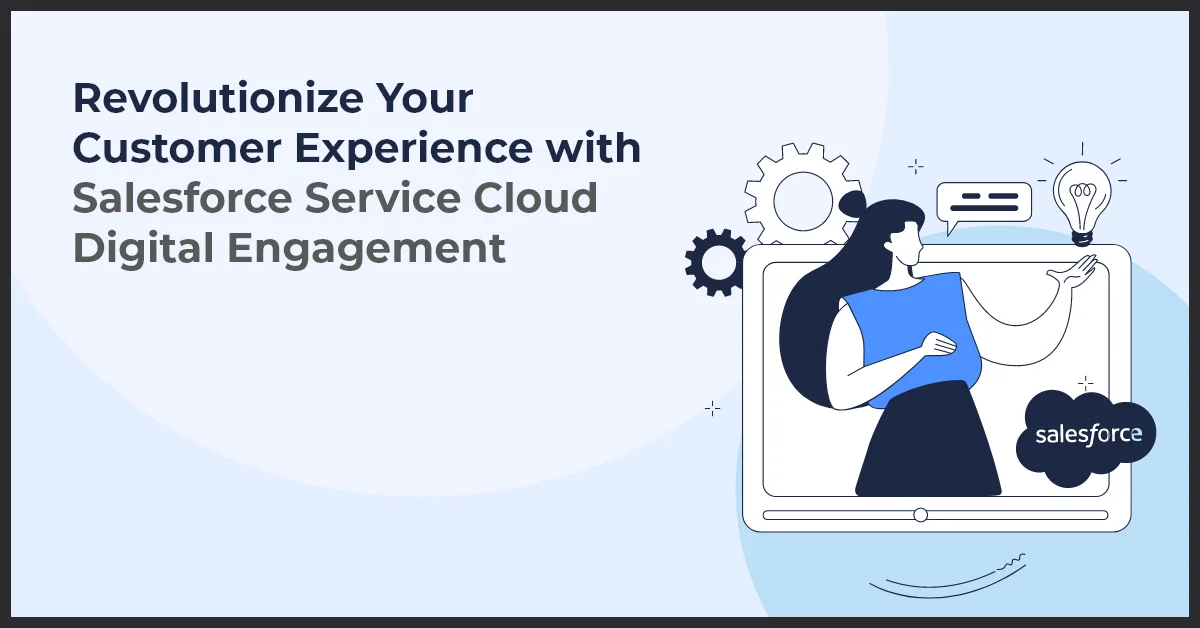Integrating Revenue Management and CPQ Solutions for Sales Excellence

Published on: May 7, 2024
Updated on: March 04, 2025
1703 Views
- Salesforce
10 min read
Revenue Management Platform & CPQ Solution: Streamline Pricing and Sales Efficiency
As your business expands, the increasing complexity in product lines, service additions, accessory bundles, discount offers, third-party components, multiple channels, and additional geographies can create challenges for sales representatives in closing deals.
CPQ (Configure Price Quote) emerges as a valuable solution for both SMEs and large organizations, enabling sales channels to automate the sales process, reduce revenue leakage, and mitigate risks effectively.
But, that’s not it. Managing revenue that is coming from sales is equally important. It ensures financial stability, informed decision-making, and a pathway to sustainable growth. To achieve this, it’s crucial to have your financial and sales processes seamlessly synchronized, providing you with a unified view of data across your organization.
And that’s where integrating your CPQ solution with a revenue management platform comes into play. When CPQ and a revenue management platform join forces, their collaboration streamlines sales processes, improves accuracy in quoting and pricing, and optimizes revenue streams.
In this blog post, we'll introduce revenue management platforms and CPQ Solutions – the ultimate team to make your sales smoother. Learn how they simplify work and boost profits.
What are Revenue Management Platforms (RMPs)?
Revenue management platforms (RMPs) are software applications that help businesses optimize their pricing and inventory strategies. They collect data from various sources, such as historical sales data, competitor pricing, and market trends. This data is then used to generate recommendations for pricing, inventory allocation, and promotions.
Key Features Contributing to Revenue Optimization:
Revenue management software helps businesses optimize pricing and inventory to maximize revenues. Some of the core capabilities include:
- 360-degree View of Customers: Consolidating customer data across systems provides a comprehensive view of engagement and needs. It enables better segmentation and tailored pricing. RMPs can also group customers into segments based on common characteristics like demographics for customized pricing and offers.
- Price Optimization: The software analyzes factors like demand, market conditions, and competitive pricing to recommend optimal price points. It ensures pricing is set to maximize both profitability and demand. It also tracks competitors' pricing and availability so businesses can benchmark and adjust their pricing strategy. Plus, RMPs usually support multiple currencies and geographies to optimize international pricing.
- Inventory Management: The system tracks available inventory across multiple sales channels. Organizations can set allotments by channel, control overbooking, and implement availability restrictions. RMPs can also forecast future demand across different customer segments, allowing you to make better pricing and availability decisions.
- Reporting & Analytics: These platforms collect and analyze vast amounts of information on everything from pricing trends to customer behavior. They are usually platform agnostic and can retrieve data from diverse systems. They then present this data in clear, actionable dashboards and reports, giving you valuable insights to optimize your pricing strategy, identify growth opportunities, and make data-driven decisions. Users can generate reports and dashboards to derive pricing insights and finetune their strategy.
What are Configure, Price, Quote (CPQ) Solutions?
CPQ solutions are software applications that help businesses automate the sales quoting process. They do this by letting users configure products and services, price them based on rules and constraints, and generate quotes. CPQ solutions can also help businesses track and manage their sales pipeline.
How CPQ Streamlines Product Configuration, Pricing, and Quoting:
CPQ software excels in customizing products for customer needs, whether simple or complex. It streamlines quoting by considering product relationships, pricing, and discounts, leading to professional proposals. This software ranges from basic tools for quick product entry and quote generation to advanced systems integrating with ERP for shipping and inventory management.
CPQ enhances sales efficiency by guiding reps through the quoting process with a Sales Playbook, ensuring accurate configurations, pricing consistency, and quick approvals. Its product rules template simplifies complex SKU choices into a clear Q&A format, offering tailored cross-sell and upsell recommendations.
The system also generates automated pricing quotes, including visual comparisons and audit trails, allowing sales managers to track all changes in real-time. CPQ’s benefits are multifold:
- Accurate Quotes: It integrates various data points for precise quoting.
- Higher Lead Conversion: Quick, custom quotes significantly improve lead conversion rates.
- Faster Quote Generation: What used to take days now takes minutes, enhancing customer experiences and closing rates.
- Shorter Sales Cycles: Efficient quoting shortens the sales process.
- Larger Deals: Automated pricing controls profit margins and guides reps in upselling and cross-selling, increasing deal sizes.
Integration Synergy: RMP and CPQ Collaboration
RMP and CPQ are two software systems that can be used together to improve sales processes and increase revenue. When done correctly, it establishes a centralized pricing foundation that enhances visibility, controls, analytics, and agility while aligning sales and finance. The result is optimized pricing and revenues. RMPs help you optimize your pricing and inventory levels, while CPQ software helps you configure products and generate quotes.
The Benefits of Integrating RMP and CPQ Software:
- Improved Data Accuracy: When RMP and CPQ software are integrated, they share data to improve the accuracy of your quotes and pricing.
- Faster Quoting: CPQ software can generate quotes quickly and easily. When it is integrated with an RMP, the CPQ software uses data from the RMP to generate even more accurate and competitive quotes.
- Shorter Sales Cycle: Using RMP and CPQ software together streamlines your sales process and shortens your sales cycle so you can close more deals and increase your revenue.
- Increased Deal Size: RMP software helps you optimize your pricing while CPQ software helps you upsell and cross-sell products, leading to larger deal sizes.
- Closed-loop Analytics: CPQ-RM integration provides closed-loop analytics from broad market insights down to deal-level execution. Businesses gain greater visibility into performance at both micro and macro levels.
Challenges in RMP and CPQ Integration
While integrating RMP and CPQ solutions promises big benefits, the journey isn't always smooth sailing. Here are some common challenges businesses face during deployment:
1. Data Integration and Quality
- Disparate Data Sources: Integrating data from various CRMs, ERP systems, and legacy databases can be complex and time-consuming.
- Data Quality Issues: Inconsistent or inaccurate data in any source can lead to pricing, quotes, and inventory management errors.
- Standardization Challenges: Bringing different data formats and structures into harmony can be a technical hurdle.
2. Change Management and User Adoption
- Resistance to Change: Sales teams accustomed to older processes might push back against adopting new technology.
- Training and Support: Continuous training and ongoing support are crucial for users to fully utilize both platforms' functionalities.
- Workflow Disruption: Integrating RMP and CPQ can disrupt existing workflows, requiring careful planning and communication to minimize disruption.
3. Technical and Implementation Challenges
- System Compatibility: Ensuring seamless integration between different software platforms can be tricky.
- Customization Needs: Businesses might require specific customizations to fit their unique needs, adding complexity to the deployment process.
- Hidden Costs: Additional costs like system maintenance, data migration, and ongoing integrations can arise beyond the initial investment.
4. Hidden ROI and Metrics Dilemma
- Measuring Success: Attributing specific revenue gains to RMP and CPQ integration can be difficult, making it hard to demonstrate ROI.
- Long-term Commitment: Success often requires sustained effort and continuous optimization, not just a one-time implementation.
Strategies to Overcome the Integration Challenges
Overcoming the challenges of RMP and CPQ solutions integration requires adopting effective strategies. Here are the practical solutions to address common deployment obstacles, ensuring a smoother and more successful implementation:
- Prioritize Data Quality and Cleansing: Invest in data cleansing and standardization before integration.
- Involve Stakeholders Early: Get buy-in from sales, marketing, and IT teams to ensure smooth adoption.
- Plan for Change Management: Provide comprehensive training, support, and communication to ease the transition.
- Choose Compatible Systems: Opt for platforms with pre-built integrations to minimize technical headaches.
- Start Small and Scale Gradually: Pilot the integration with a smaller group before full deployment.
- Focus on Measurable Metrics: Define clear KPIs and track progress regularly to showcase the impact of the integration.
Factors to Consider When Evaluating RMP and CPQ Solutions
When evaluating RMP and CPQ solutions, careful consideration of key factors is essential for making informed decisions. Here are some key factors to consider:
- Integration Capabilities: The chosen RMP and CPQ solutions should seamlessly integrate with existing backend systems like ERP, CRM, eCommerce platforms, etc. API-led connectivity is essential for real-time data sharing. Assess how easily both platforms can be connected and synchronized.
- Data and Analytics: Robust analytics capabilities should provide insights into customer segmentation, elasticity modeling, price optimization, deal profitability, and more. Reporting and dashboards should give visibility into pricing KPIs at portfolio and transactional levels. Advanced machine learning algorithms can identify trends and patterns to inform pricing decisions.
- Omnichannel Support: With today's omnichannel selling, consistent pricing across all touchpoints is critical. Evaluate if the platforms can centralize pricing across all direct and indirect sales channels including brick-and-mortar stores, eCommerce, contact centers, mobile, etc.
- Global Capabilities: For global businesses, the solutions should accommodate different geographic pricing requirements related to taxes, currencies, business rules, compliance, etc. Look for capabilities like multi-currency and multi-language support.
- Flexible Pricing Rules: The systems should allow configurable rules for pricing constraints, thresholds, margins, discounts, approvals, etc. Drag-and-drop interfaces make it easier to build and maintain complex pricing logic.
- Performance and Scalability: Solutions should use high-performance architecture to support pricing updates across thousands of transactions in near real-time. Regular stress testing ensures platforms can scale to maximum volumes during promotions or seasonal peaks.
- AI and Machine Learning: Leveraging AI and ML takes pricing strategies to the next level via predictive models, what-if simulations, competitive pricing analysis, and optimization recommendations. Seek advanced self-learning capabilities.
- Cloud vs. On-premise: Cloud systems simplify deployment and maintenance but may have higher long-term costs. On-premise allows customization but needs internal infrastructure/skills. Weigh benefits like flexibility, control, and costs.
- Total Cost of Ownership: Calculate direct licensing, implementation, and customization costs along with indirect IT, training, and support costs. Project both initial and recurring costs over a multi-year period for complete TCO.
- Vendor Profile: Look for stable vendors with deep pricing experience across products and industries. Ask about their client base, roadmap, vision, and ongoing innovation in pricing technology.
Final Words
RMP and CPQ solutions significantly enhance sales processes. RMPs optimize pricing and inventory with a comprehensive customer view, while CPQs streamline product configuration and quoting, accelerating the sales cycle and increasing profitability.
Integrating these solutions promises greater accuracy, faster sales cycles, and larger deals. However, you must strategically manage data integration, change management, and technical compatibility challenges.
When selecting RMP and CPQ solutions, consider factors like integration ease, data analytics strength, omnichannel support, and global functionality. The right choice, balancing cost and capabilities, can transform sales efficiency and drive revenue growth.
Ready to Revolutionize Sales Success with RMP and CPQ Solutions? Let’s Talk!
The experts at Growth Natives would love to help you integrate these two solutions. Drop us a line at info@growthnatives.com, and we will take it from there.
Frequently Asked Questions
CPQ stands for Configure, Price, Quote. It’s a software solution that helps sales teams generate accurate quotes for complex products or services by configuring them according to customer requirements, pricing them correctly, and delivering professional quotes quickly.
Integrating an RMP with a CPQ solution allows businesses to align their pricing and quoting processes with revenue goals and market conditions. It ensures that sales teams have access to real-time pricing data and insights, enabling them to make informed decisions and optimize deal profitability.
The integration process typically involves connecting the RMP and CPQ solutions through APIs (Application Programming Interfaces) or middleware platforms. Data such as pricing rules, product configurations, and customer information is synchronized between the two systems in real-time or through batch processes.
Businesses across various industries, including manufacturing, technology, telecommunications, and services, can benefit from integrating RMP and CPQ solutions. Any organization that deals with complex pricing structures, customized products or services, and multiple sales channels can achieve sales excellence through this integration.



